Your roof is one of the most critical components of your home. It provides shelter, protection, and insulation from the elements. Over time, wear and tear can take a toll on your roof, leading to potential problems that may require professional attention. However, being proactive and regularly – and safely – inspecting your roof can help you identify issues early, potentially saving you from costly repairs or replacements. Luckily, the experts at Gunner Roofing know exactly what to look for and can guide you through the process of self-diagnosing your roof to spot potential issues before they escalate.
Exterior inspection: look but don’t climb
Start your self-diagnosis by examining the exterior of your roof. Prioritize your safety – if you’re uncomfortable or unsure about climbing on your roof, it’s time to call in professionals like Gunner. Stand at a distance and carefully observe, looking for shingle damage. Another option is to fly a drone with a camera over your roof to inspect it more closely without climbing onto the roof itself (just make sure to follow all ordinances regarding flying a drone).
When inspecting your roof’s exterior, focus on the shingles or roofing material. Check for missing, cracked, or damaged shingles that can lead to leaks. Watch for signs of curling or buckling, indicating aging or water damage, and be wary of moss or algae growth, which signals moisture retention and potential rot.

Moss can absorb moisture which can lead to wood rot on a roof
Another critical aspect to inspect is the roof flashing around chimneys, vents, and skylights. Look for signs of corrosion or damage in the flashing material, which could compromise its ability to keep water out. Look for secure attachment and proper sealing to prevent potential leaks. Well-maintained flashing is vital for protecting your roof from moisture-related issues.
Don’t overlook your gutters and downspouts during your exterior examination. Remove debris to prevent clogged gutters and ensure proper water drainage. Check for sagging or damage in these components, which are crucial for directing water away from your roof and foundation. Ensure free-flowing downspouts to keep water moving and to avoid pooling near the foundation, which can lead to structural problems over time.
Lastly, when examining your roof’s exterior, pay attention to roof penetrations like satellite dishes or vents. Look closely for signs of leaks or damage in these areas, as they can be vulnerable points where water may infiltrate if not properly sealed or maintained. Identifying and addressing issues with roof penetrations is essential to prevent a leak and potential interior water damage.
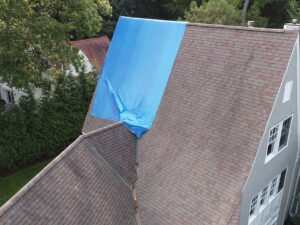
Gunner provides emergency roof services
Interior inspection
For your roof’s interior inspection, begin by examining the attic. If accessing your attic seems risky or if you discover signs of serious damage, it’s advisable to seek professional help. With a flashlight in hand, check the ceiling and walls for signs of water stains, moisture, or mold. These visual indicators may suggest a roof leak or ventilation problems. Also, be on the lookout for daylight penetrating through roof boards, indicating potential gaps or leaks requiring attention. Additionally, look for proper insulation of exposed pipes or ducts in the attic to further prevent moisture buildup and condensation, which can contribute to moisture-related issues. These attic inspection steps are vital for identifying and addressing interior roof problems.
When evaluating your roof’s interior, ventilation in the attic space is crucial. Check that your attic maintains sufficient ventilation to prevent water buildup and related issues. Watch for inadequate or poor ventilation throughout, such as excessive heat or humidity within the attic. Proper attic ventilation is essential for maintaining a healthy, moisture-free environment, ultimately contributing to the long-term functionality and life span of your roof.
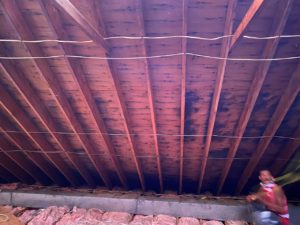
Improper ventilation can lead to mold growth
Water damage
Detecting water damage within your home is not only crucial for maintaining a healthy roof but also for preserving the overall integrity of your property. Begin by checking your ceilings and walls for any discoloration or water stains, as these are often telltale signs of a roof leak. These unsightly marks can not only compromise the aesthetics of your home but also signal potential structural issues. Moreover, be attentive to any musty odors in your living space, as they can serve as indicators of hidden water damage and mold growth. Another aspect to consider is peeling paint or wallpaper, particularly near the roofline, as this may result from water infiltration, which can weaken your home’s structure over time. Lastly, check your ceiling for any sagging or bulging, as these can be indicative of water damage or even structural issues that require immediate attention. Identifying these signs early through thorough inspections can help you address and resolve potential roof damage or problems promptly, preventing further damage and costly repairs down the road.
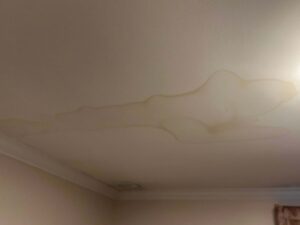
Water damage on ceiling caused by a roof leak
Storm damage
Storms can wreak havoc on your home in various ways, from the visible exterior signs like missing shingles, dented roof vents, and damaged flashing, to the less obvious interior consequences such as water stains, moisture buildup, and mold growth. Hail damage, for instance, can cause granule loss on your shingles, which not only compromises the aesthetic appeal of your roof but also reduces its ability to protect your home. Wind damage can lift and loosen shingles, making your roof susceptible to leaks and further deterioration. Additionally, fallen tree branches and debris during a storm can puncture your roof, leading to structural damage and the need for extensive repairs.
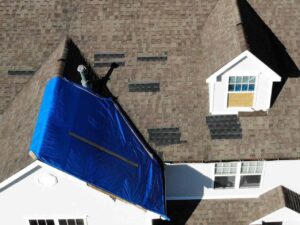
Shingles missing from wind damage
It’s crucial to understand that storm damage can extend beyond your roof. Strong winds can cause siding to become loose or damaged, windows to break, and gutters to become clogged or even broken. Left unchecked, these issues can lead to further problems, such as moisture infiltration, mold, and compromised structural integrity.
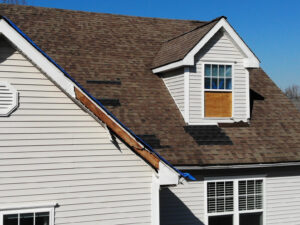
Wind-damaged fascia
To safeguard your home from storm effects, it’s advisable to take proactive measures. Regular roof inspections, especially after severe weather events, can help you spot signs of roof damage early and address them promptly. Additionally, consider having your roof reinforced with impact-resistant materials and your home’s exterior reinforced to better withstand high winds and extreme weather conditions. Being prepared and proactive can make a significant difference in protecting your home and saving you money on extensive repairs or complete replacements.
Roof age
Knowing the age of your roof is essential for self-diagnosis, and it’s also where the expertise of professionals like Gunner Roofing comes into play. Different roofing materials have varying life spans, and the experienced roofing experts at Gunner can provide valuable insights into your roof’s condition. For instance, asphalt shingles typically last 20-30 years, while metal roofs can last 50 years or more. If your roof is nearing the end of its expected life span, Gunner Roofing recommends being extra vigilant in your inspections.
Gunner understands the intricacies of various roofing materials and their vulnerability to damages. We can guide you through the process of self-diagnosing your roof and identifying signs of wear and tear, particularly if your roof is aging. Our expertise can be invaluable in ensuring that you keep a well-maintained roof and that any potential issues are addressed promptly. Whether it’s a routine inspection or comprehensive roofing services, Gunner is your trusted partner in safeguarding your home against the elements and storm-related damage.
DIY roof repair vs. professional help
While self-diagnosis can offer initial insights into potential roofing issues, understanding the critical moment to engage professional assistance is essential. If you come across extensive damage, including a significant number of missing shingles, major leaks, structural issues like sagging or a weakened roof deck, or repeated cases of water damage and mold growth, it’s time to contact the experts at Gunner. Additionally, complex repairs that necessitate specialized equipment or expertise also warrant the intervention of seasoned professionals. In these scenarios, the expertise and resources of Gunner’s team are invaluable for addressing these serious roofing challenges effectively.
Contact Gunner Roofing
Self-diagnosing your roof is a proactive approach to ensure that your home remains well-protected against the elements. Regularly inspecting both the exterior and interior of your roof allows you to identify potential issues early and take appropriate action. While DIY inspections are valuable, it’s crucial to recognize when to rely on the expertise of Gunner.
If you notice any of the common signs mentioned above, don’t hesitate to contact Gunner Roofing to address your roofing needs promptly. Our experienced team can provide the necessary solutions to ensure the longevity of your roof and maintain the safety and comfort of your home for years to come.